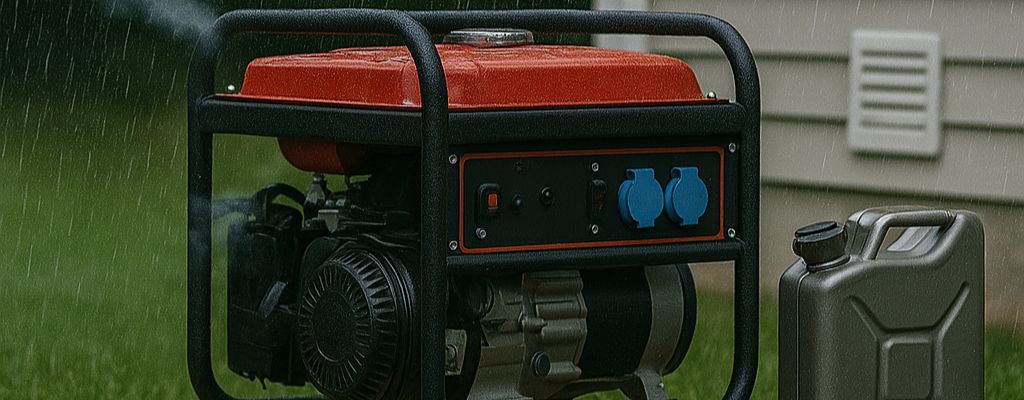
Where to Put a Generator in a Storm?
Generators are the unsung heroes of storm season—but only if you park them in the right spot. The short answer? Outside, dry, well-ventilated, and nowhere near the house. Stick around, and you’ll learn how to keep yours safe from rain, wind, floodwater, and even the odd nosy kangaroo.

Where do you put a generator during a storm? Prioritising safe outdoor placement
Finding a safe home for your generator during wild weather isn’t about convenience—it’s about avoiding serious hazards. The rule is simple: keep it outside, in a spot that’s dry, has plenty of fresh air, and is far enough from living spaces.
This helps you dodge carbon monoxide dangers, fire risks, and damage from the elements. Get the placement right, and your generator will work harder, last longer, and keep your home running when the lights go out.
Carbon monoxide: the foremost concern for any generator in a storm
Understanding the invisible threat of exhaust fumes from your generator
Every generator produces carbon monoxide, a gas you can’t see or smell but can be deadly in minutes. In stormy weather, when doors and windows are tightly shut, it’s easy for fumes to creep inside if the generator is too close.
Why your generator must always be operated outdoors, far from openings
The golden rule? Never run your generator in the garage, a shed, or under a patio roof. Keep it well clear of windows, doors, and vents—any opening that could let fumes inside your home or your neighbour’s.
Maintaining safe distances for your generator during a storm
The critical "20-foot rule": keeping your generator away from doors, windows, and vents
Place your generator at least six metres—about 20 feet—from any building. That gap helps prevent exhaust fumes from drifting inside and lowers the chance of sparks causing a fire.
Directing exhaust away from your property and neighbours to prevent fume entry
Make sure the exhaust blows away from people and buildings. A bit of thought here keeps the air safe for everyone and avoids those awkward neighbourly complaints.
Fire hazards and fuel management in stormy conditions for your generator
Storing fuel safely and refuelling your generator when it's cool and dry
Always store petrol or diesel in proper containers, away from your generator. If you need to refuel, turn it off, let it cool completely, and top up in a dry, sheltered spot.
Keeping your generator away from combustible materials and structures
Don’t tuck your generator under a tree, against a timber fence, or next to a pile of cardboard boxes. One spark plus wild wind is a recipe for trouble.

Should you run a generator during a storm? Safe operation and protection
Generators are built to keep things running when the power cuts out, but storm conditions can make using them tricky. The aim is to balance your need for electricity with staying safe.
How to use a portable generator during a storm: operational best practices
Ensuring your portable generator is on a stable, dry, and elevated surface
Set it up on level ground to avoid tipping. In flood-prone areas, use a sturdy, raised platform to keep it high and dry.
What to do if water accumulates around your portable generator
If you notice water pooling near your generator, shut it down straight away. Electricity and water are not mates, and even a shallow puddle can cause a dangerous shock or fry the machine.
Essential covers for your generator during a storm
The benefits of a generator cover for weather protection
A good waterproof cover shields your generator from heavy rain. It also helps it run more reliably and last longer.
Utilising a generator tent or generator canopy for enhanced shelter
Special tents or canopies designed for generators keep the rain out but let air circulate. They’re a safer choice than makeshift tarps, which can trap heat and fumes.
Is it advisable to run my generator during a storm? Assessing risks vs. needs
When to safely operate your generator and when to shut down due to severe weather
If winds are dangerously high, floodwaters are on the way, or lightning is cracking overhead, switch it off. Wait until conditions settle before firing it up again.
The importance of carbon monoxide alarms with your generator during storms
Install carbon monoxide alarms inside your home. They’ll warn you if fumes manage to sneak inside despite your best efforts.

Pre-storm preparation and post-storm procedures for your generator
Preparing your generator for the onset of a storm
Performing a test run and ensuring adequate fuel supply for your generator
Give your generator a quick test before the weather turns ugly. Stock up on enough fuel—stored safely—to see you through a possible outage.
Securing your generator against high winds and flying debris
In high-wind zones, anchor it down or use heavy tie-downs to stop it from shifting or tipping over.
Post-storm actions: safe shutdown and storage of your generator
Allowing your generator to cool down before handling or refuelling
Once you’re ready to shut it down, let it cool for at least 15 minutes before you move it or add fuel.
Proper storage of your generator when the storm has passed
When the job’s done, store it in a dry, ventilated space—fuel removed—until you need it again.
Conclusion: strategic generator placement and safe operation ensure power continuity during storms
The safest place for your generator during a storm is outside, dry, well-ventilated, and far from the house. Combine smart placement with a bit of preparation, safe handling, and post-storm care, and you’ll have reliable power without putting yourself—or anyone else—at risk, even when the weather’s wild.


